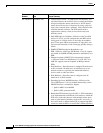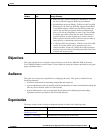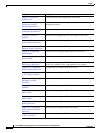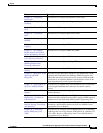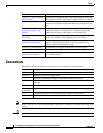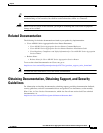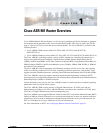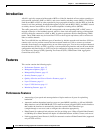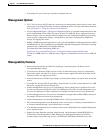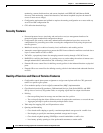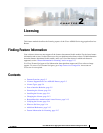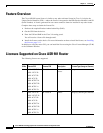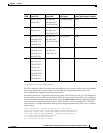
1-2
Cisco ASR 901 Series Aggregation Services Router Software Configuration Guide
OL-23826-09
Chapter 1 Cisco ASR 901 Router Overview
Introduction
Introduction
A RAN is typically composed of thousands of BTSs or Node Bs, hundreds of base station controllers or
radio network controllers (BSCs or RNCs), and several mobile switching centers (MSCs). The BTS or
Node Bs and BSC or RNC are often separated by large geographic distances, with the BTSs or Node Bs
located in cell sites uniformly distributed throughout a region, and the BSCs, RNCs, and MSCs located
at suitably chosen Central Offices (CO) or mobile telephone switching offices (MTSO).
The traffic generated by a BTS or Node B is transported to the corresponding BSC or RNC across a
network, referred to as the backhaul network, which is often a hub-and-spoke topology with hundreds
of BTS or Node Bs connected to a BSC or RNC by point-to-point time division multiplexing (TDM)
trunks. These TDM trunks may be leased-line T1/E1s or their logical equivalents, such as microwave
links or satellite channels.
The Cisco ASR 901 has two different types of interfaces by default: network node interfaces (NNIs) to
connect to the service provider network and user network interfaces (UNIs) to connect to customer
networks. Some features are supported only on one of these port types. You can also configure enhanced
network interfaces (ENIs). An ENI is typically a user-network facing interface and has the same default
configuration and functionality as UNIs, but can be configured to support protocol control packets for
Cisco Discovery Protocol (CDP), Spanning-Tree Protocol (STP), EtherChannel Link Aggregation
Control Protocol (LACP).
Features
This section contains the following topics:
• Performance Features, page 1-2
• Management Options, page 1-3
• Manageability Features, page 1-3
• Security Features, page 1-4
• Quality of Service and Class of Service Features, page 1-4
• Layer 3 Features, page 1-5
• Layer 3 VPN Services, page 1-5
• Monitoring Features, page 1-5
Performance Features
• Autosensing of port speed and autonegotiation of duplex mode on all ports for optimizing
bandwidth.
• Automatic-medium-dependent interface crossover (auto-MDIX) capability on 100 and 100/1000
Mbps interfaces and on 100/1000 BASE-T/TX small form-factor pluggable (SFP) module interfaces
that enables the interface to automatically detect the required cable connection type
(straight-through or crossover) and to configure the connection appropriately.
• EtherChannel for enhanced fault tolerance and for providing up to 8 Gbps (Gigabit EtherChannel)
or 800 Mbps (Fast EtherChannel) full duplex of bandwidth between switches, routers, and servers.
• Link Aggregation Control Protocol (LACP) for automatic creation of EtherChannel links (supported
only on NNIs or ENIs).



